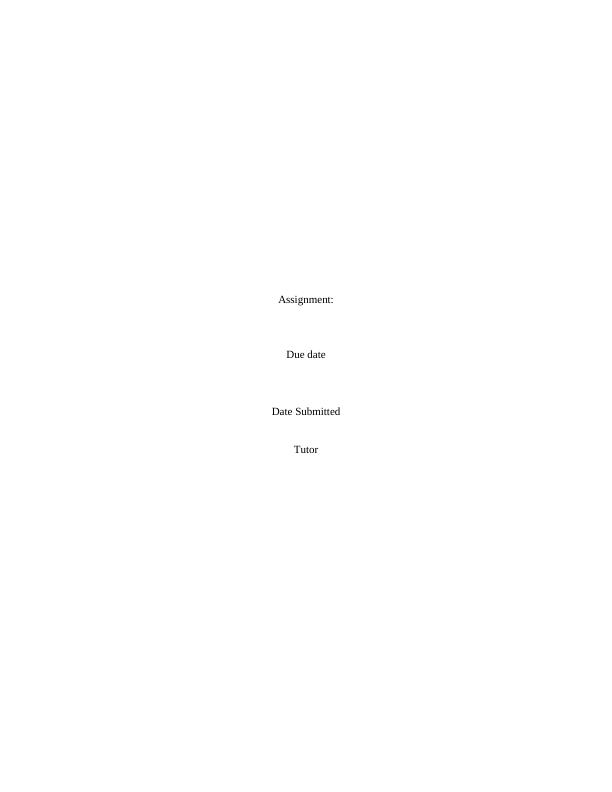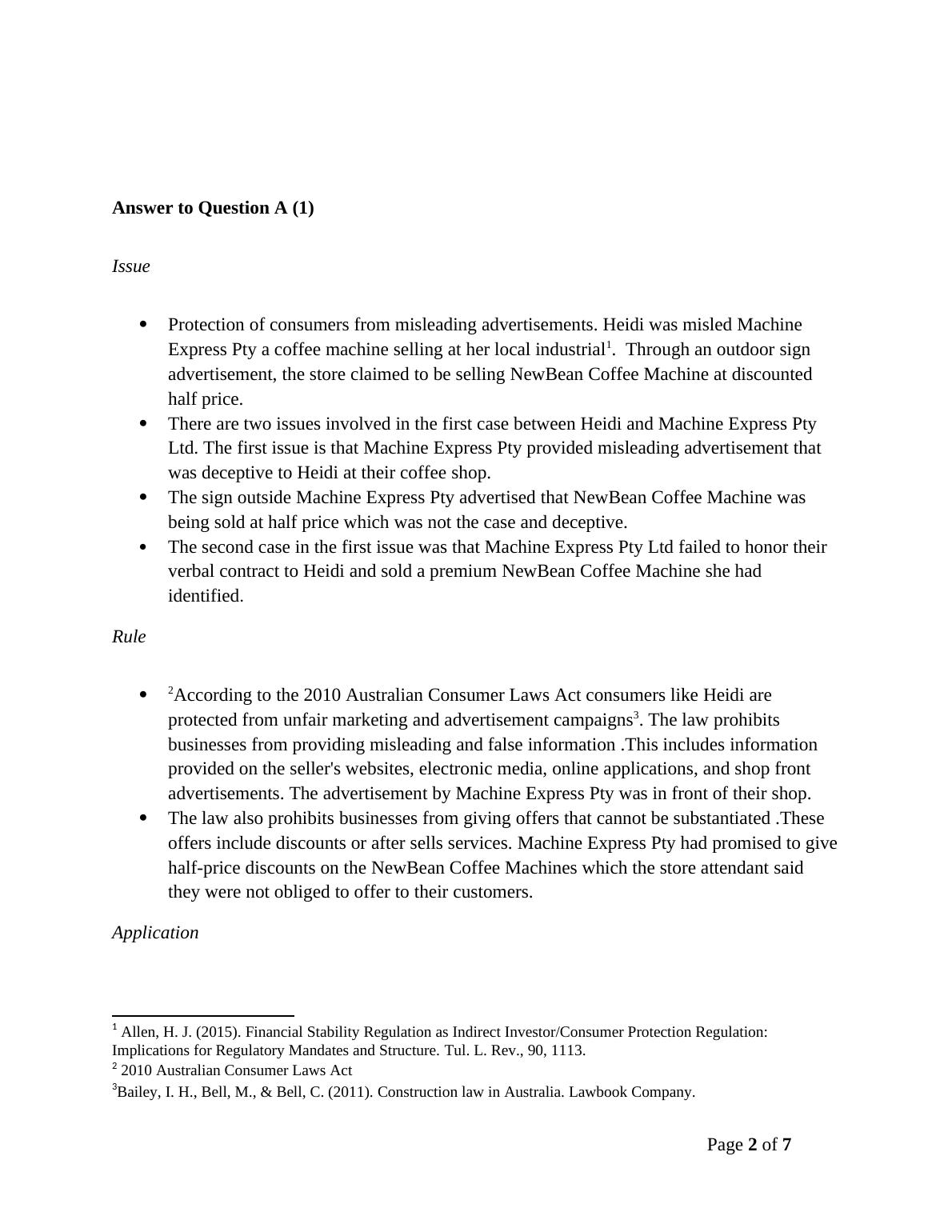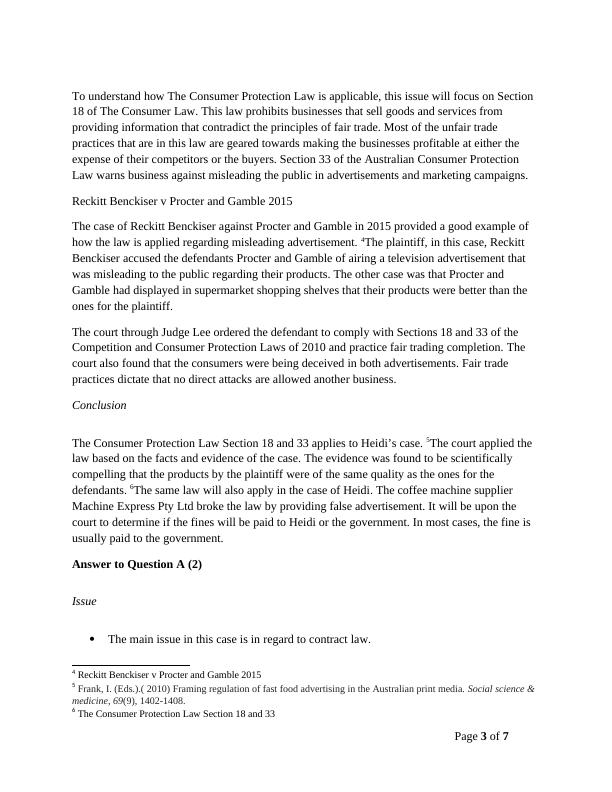Consumer Protection Laws and Contract Law: A Case Study of Heidi
Added on 2023-02-01
7 Pages2363 Words33 Views
Assignment:
Due date
Date Submitted
Tutor
Due date
Date Submitted
Tutor

Answer to Question A (1)
Issue
Protection of consumers from misleading advertisements. Heidi was misled Machine
Express Pty a coffee machine selling at her local industrial1. Through an outdoor sign
advertisement, the store claimed to be selling NewBean Coffee Machine at discounted
half price.
There are two issues involved in the first case between Heidi and Machine Express Pty
Ltd. The first issue is that Machine Express Pty provided misleading advertisement that
was deceptive to Heidi at their coffee shop.
The sign outside Machine Express Pty advertised that NewBean Coffee Machine was
being sold at half price which was not the case and deceptive.
The second case in the first issue was that Machine Express Pty Ltd failed to honor their
verbal contract to Heidi and sold a premium NewBean Coffee Machine she had
identified.
Rule
2According to the 2010 Australian Consumer Laws Act consumers like Heidi are
protected from unfair marketing and advertisement campaigns3. The law prohibits
businesses from providing misleading and false information .This includes information
provided on the seller's websites, electronic media, online applications, and shop front
advertisements. The advertisement by Machine Express Pty was in front of their shop.
The law also prohibits businesses from giving offers that cannot be substantiated .These
offers include discounts or after sells services. Machine Express Pty had promised to give
half-price discounts on the NewBean Coffee Machines which the store attendant said
they were not obliged to offer to their customers.
Application
1 Allen, H. J. (2015). Financial Stability Regulation as Indirect Investor/Consumer Protection Regulation:
Implications for Regulatory Mandates and Structure. Tul. L. Rev., 90, 1113.
2 2010 Australian Consumer Laws Act
3Bailey, I. H., Bell, M., & Bell, C. (2011). Construction law in Australia. Lawbook Company.
Page 2 of 7
Issue
Protection of consumers from misleading advertisements. Heidi was misled Machine
Express Pty a coffee machine selling at her local industrial1. Through an outdoor sign
advertisement, the store claimed to be selling NewBean Coffee Machine at discounted
half price.
There are two issues involved in the first case between Heidi and Machine Express Pty
Ltd. The first issue is that Machine Express Pty provided misleading advertisement that
was deceptive to Heidi at their coffee shop.
The sign outside Machine Express Pty advertised that NewBean Coffee Machine was
being sold at half price which was not the case and deceptive.
The second case in the first issue was that Machine Express Pty Ltd failed to honor their
verbal contract to Heidi and sold a premium NewBean Coffee Machine she had
identified.
Rule
2According to the 2010 Australian Consumer Laws Act consumers like Heidi are
protected from unfair marketing and advertisement campaigns3. The law prohibits
businesses from providing misleading and false information .This includes information
provided on the seller's websites, electronic media, online applications, and shop front
advertisements. The advertisement by Machine Express Pty was in front of their shop.
The law also prohibits businesses from giving offers that cannot be substantiated .These
offers include discounts or after sells services. Machine Express Pty had promised to give
half-price discounts on the NewBean Coffee Machines which the store attendant said
they were not obliged to offer to their customers.
Application
1 Allen, H. J. (2015). Financial Stability Regulation as Indirect Investor/Consumer Protection Regulation:
Implications for Regulatory Mandates and Structure. Tul. L. Rev., 90, 1113.
2 2010 Australian Consumer Laws Act
3Bailey, I. H., Bell, M., & Bell, C. (2011). Construction law in Australia. Lawbook Company.
Page 2 of 7

To understand how The Consumer Protection Law is applicable, this issue will focus on Section
18 of The Consumer Law. This law prohibits businesses that sell goods and services from
providing information that contradict the principles of fair trade. Most of the unfair trade
practices that are in this law are geared towards making the businesses profitable at either the
expense of their competitors or the buyers. Section 33 of the Australian Consumer Protection
Law warns business against misleading the public in advertisements and marketing campaigns.
Reckitt Benckiser v Procter and Gamble 2015
The case of Reckitt Benckiser against Procter and Gamble in 2015 provided a good example of
how the law is applied regarding misleading advertisement. 4The plaintiff, in this case, Reckitt
Benckiser accused the defendants Procter and Gamble of airing a television advertisement that
was misleading to the public regarding their products. The other case was that Procter and
Gamble had displayed in supermarket shopping shelves that their products were better than the
ones for the plaintiff.
The court through Judge Lee ordered the defendant to comply with Sections 18 and 33 of the
Competition and Consumer Protection Laws of 2010 and practice fair trading completion. The
court also found that the consumers were being deceived in both advertisements. Fair trade
practices dictate that no direct attacks are allowed another business.
Conclusion
The Consumer Protection Law Section 18 and 33 applies to Heidi’s case. 5The court applied the
law based on the facts and evidence of the case. The evidence was found to be scientifically
compelling that the products by the plaintiff were of the same quality as the ones for the
defendants. 6The same law will also apply in the case of Heidi. The coffee machine supplier
Machine Express Pty Ltd broke the law by providing false advertisement. It will be upon the
court to determine if the fines will be paid to Heidi or the government. In most cases, the fine is
usually paid to the government.
Answer to Question A (2)
Issue
The main issue in this case is in regard to contract law.
4 Reckitt Benckiser v Procter and Gamble 2015
5 Frank, I. (Eds.).( 2010) Framing regulation of fast food advertising in the Australian print media. Social science &
medicine, 69(9), 1402-1408.
6 The Consumer Protection Law Section 18 and 33
Page 3 of 7
18 of The Consumer Law. This law prohibits businesses that sell goods and services from
providing information that contradict the principles of fair trade. Most of the unfair trade
practices that are in this law are geared towards making the businesses profitable at either the
expense of their competitors or the buyers. Section 33 of the Australian Consumer Protection
Law warns business against misleading the public in advertisements and marketing campaigns.
Reckitt Benckiser v Procter and Gamble 2015
The case of Reckitt Benckiser against Procter and Gamble in 2015 provided a good example of
how the law is applied regarding misleading advertisement. 4The plaintiff, in this case, Reckitt
Benckiser accused the defendants Procter and Gamble of airing a television advertisement that
was misleading to the public regarding their products. The other case was that Procter and
Gamble had displayed in supermarket shopping shelves that their products were better than the
ones for the plaintiff.
The court through Judge Lee ordered the defendant to comply with Sections 18 and 33 of the
Competition and Consumer Protection Laws of 2010 and practice fair trading completion. The
court also found that the consumers were being deceived in both advertisements. Fair trade
practices dictate that no direct attacks are allowed another business.
Conclusion
The Consumer Protection Law Section 18 and 33 applies to Heidi’s case. 5The court applied the
law based on the facts and evidence of the case. The evidence was found to be scientifically
compelling that the products by the plaintiff were of the same quality as the ones for the
defendants. 6The same law will also apply in the case of Heidi. The coffee machine supplier
Machine Express Pty Ltd broke the law by providing false advertisement. It will be upon the
court to determine if the fines will be paid to Heidi or the government. In most cases, the fine is
usually paid to the government.
Answer to Question A (2)
Issue
The main issue in this case is in regard to contract law.
4 Reckitt Benckiser v Procter and Gamble 2015
5 Frank, I. (Eds.).( 2010) Framing regulation of fast food advertising in the Australian print media. Social science &
medicine, 69(9), 1402-1408.
6 The Consumer Protection Law Section 18 and 33
Page 3 of 7

End of preview
Want to access all the pages? Upload your documents or become a member.
Related Documents
Legal Issues in Misleading Advertisements and Consideration in Contractslg...
|14
|3258
|1
Commercial Law : Case Studylg...
|9
|2276
|92
Australian Commercial Lawlg...
|9
|2537
|45
Consumer Laws in Australia: Protection and Remedies for Consumerslg...
|10
|2743
|97
